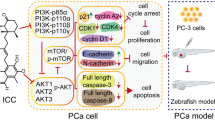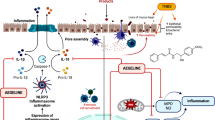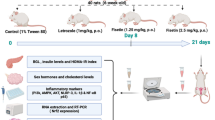Abstract
This study aims to investigate the efficacy and possible mechanisms of melatonin in treating interstitial cystitis (IC), as melatonin is involved in anti-inflammatory and immunomodulatory effects and plays an important role in neuroprotection. IC was induced by intraperitoneal injection of cyclophosphamide (CP) with melatonin pretreatment or vehicle pretreatment. On day 7, the voiding behaviors were observed. Bladders were harvested for histologic examination, analysis of the expressions of heme oxygenase-1 (HO-1) and inducible nitric oxide synthase (iNOS) by Western blotting, and also processed for immunohistochemical staining of substance P (SP). Proinflammatory cytokines were measured by ELISA immunoassays. L6-S1 spinal cords were harvested for measurement of SP by radioimmunoassay. CP injection resulted in severe cystitis with increase in voiding behaviors, histological damage, mast cell proliferation, SP, and proinflammatory cytokine expression, which were significantly downregulated by melatonin pretreatment. Pretreatment with melatonin further enhanced the expression of HO-1 and significantly reduced iNOS expression. Melatonin significantly improved bladder symptoms and histological damages in rats with CP-induced cystitis by diminishing bladder oxidative stress, blocking iNOS, upregulation of HO-1, and downregulating the expression of SP.




Similar content being viewed by others
References
Pandi-Perumal, S.R., V. Srinivasan, G.J. Maestroni, et al. 2006. Melatonin: nature’s most versatile biological signal? FEBS Journal 273: 2813–38.
Berson, D.M., F.A. Dunn, and M. Takao. 2002. Phototransduction by retinal ganglion cells that set the circadian clock. Science 295: 1070–3.
Reiter, R.J., D.X. Tan, J.C. Mayo, et al. 2003. Melatonin as an antioxidant: biochemical mechanisms and pathophysiological implications in humans. Acta Biochimica Polonica 50: 1129–46.
Kwon, K.J., J.N. Kim, M.K. Kim, et al. 2011. Melatonin synergistically increases resveratrol-induced heme oxygenase-1 expression through the inhibition of ubiquitin-dependent proteasome pathway: a possible role in neuroprotection. Journal of Pineal Research 50: 110–23.
Giannantoni, A., E. Costantini, S.M. Di Stasi, et al. 2006. Botulinum A toxin intravesical injections in the treatment of painful bladder syndrome: a pilot study. European Urology 49: 704–9.
Erickson, D.R. 2012. Identifying biomarkers for interstitial cystitis/bladder pain syndrome. Journal of Urology 187: 1958–9.
Meng, E., J.S. Young, T.L. Cha, et al. 2012. Neuronal-derived nitric oxide modulates the activity of mouse detrusor smooth muscle. Neurourology and Urodynamics 31: 572–8.
Giannantoni, A., V. Bini, R. Dmochowski, et al. 2012. Contemporary management of the painful bladder: a systematic review. European Urology 61: 29–53.
Pozo, M.J., P.J. Gomez-Pinilla, C. Camello-Almaraz, et al. 2010. Melatonin, a potential therapeutic agent for smooth muscle-related pathological conditions and aging. Current Medicinal Chemistry 17: 4150–65.
Terry, P.D., F. Villinger, G.A. Bubenik, et al. 2009. Melatonin and ulcerative colitis: evidence, biological mechanisms, and future research. Inflammatory Bowel Diseases 15: 134–40.
Srinivasan, V., S.R. Pandi-Perumal, I. Trahkt, et al. 2009. Melatonin and melatonergic drugs on sleep: possible mechanisms of action. International Journal of Neuroscience 119: 821–46.
He, H., W. Dong, and F. Huang. 2010. Anti-amyloidogenic and anti-apoptotic role of melatonin in Alzheimer disease. Current Neuropharmacology 8: 211–7.
Kovács, J., W. Brodner, V. Kirchlechner, et al. 2000. Measurement of urinary melatonin: a useful tool for monitoring serum melatonin after its oral administration. Journal of Clinical Endocrinology and Metabolism 85: 666–70.
Cetinel, S., F. Ercan, E. Cikler, et al. 2005. Protective effect of melatonin on water avoidance stress induced degeneration of the bladder. Journal of Urology 173: 267–70.
Kageyama, A., T. Fujino, Y. Taki, et al. 2008. Alteration of muscarinic and purinergic receptors in urinary bladder of rats with cyclophosphamide-induced interstitial cystitis. Neuroscience Letters 436: 81–4.
Kumar, A., and A. Singh. 2009. Possible involvement of GABAergic mechanism in protective effect of melatonin against sleep deprivation-induced behaviour modification and oxidative damage in mice. Fundamental and Clinical Pharmacology 23: 439–48.
Dickson, A., A. Avelino, F. Cruz, et al. 2006. Peptidergic sensory and parasympathetic fiber sprouting in the mucosa of the rat urinary bladder in a chronic model of cyclophosphamide-induced cystitis. Neuroscience 141: 1633–47.
Rudick, C.N., P.J. Bryce, L.A. Guichelaar, et al. 2008. Mast cell-derived histamine mediates cystitis pain. PLoS One 3: e2096.
Zhang, Q.H., X.C. Shen, Z.S. Zhou, et al. 2010. Decreased nanobacteria levels and symptoms of nanobacteria-associated interstitial cystitis/painful bladder syndrome after tetracycline treatment. International Urogynecology Journal 21: 103–9.
Westropp, J.L., and C.A. Buffington. 2002. In vivo models of interstitial cystitis. Journal of Urology 167: 694–702.
Wantuch, C., M. Piesla, and L. Leventhal. 2007. Pharmacological validation of a model of cystitis pain in the mouse. Neuroscience Letters 421: 250–2.
Joshi, S.K., J.P. Mikusa, B. Weaver, et al. 2008. Morphine and ABT-594 (a nicotinic acetylcholine agonist) exert centrally mediated antinociception in the rat cyclophosphamide cystitis model of visceral pain. The Journal of Pain 9: 146–56.
Topal, T., Y. Oztas, A. Korkmaz, et al. 2005. Melatonin ameliorates bladder damage induced by cyclophosphamide in rats. Journal of Pineal Research 38: 272–7.
Matsuoka, Y., H. Masuda, M. Yokoyama, et al. 2007. Protective effects of heme oxygenase-1 against cyclophosphamide-induced haemorrhagic cystitis in rats. BJU International 100: 1402–8.
Ochodnický, P., C.D. Cruz, N. Yoshimura, and M.C. Michel. 2011. Nerve growth factor in bladder dysfunction: contributing factor, biomarker, and therapeutic target. Neurourology and Urodynamics 30: 1227–41.
Cervero, F., and J.M. Laird. 1999. Visceral pain. Lancet 353: 2145–8.
Korkmaz, A., R.J. Reiter, T. Topal, et al. 2009. Melatonin: an established antioxidant worthy of use in clinical trials. Molecular Medicine 15: 43–50.
Acknowledgments
This study was supported by the National Natural Science Foundation of China no. 81000241.
Conflicts of Interest
None
Author information
Authors and Affiliations
Corresponding author
Rights and permissions
About this article
Cite this article
Zhang, Qh., Zhou, Zs., Lu, Gs. et al. Melatonin Improves Bladder Symptoms and May Ameliorate Bladder Damage via Increasing HO-1 in Rats. Inflammation 36, 651–657 (2013). https://doi.org/10.1007/s10753-012-9588-5
Published:
Issue Date:
DOI: https://doi.org/10.1007/s10753-012-9588-5




